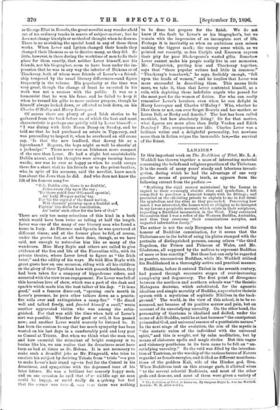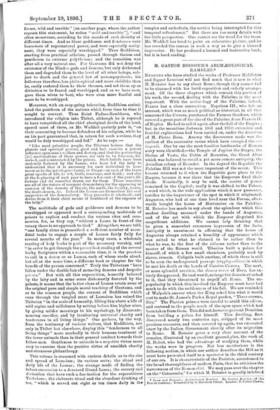LAMAISM*
Ix this important work on The Buddhism. of Tibet, Mr. L. A. Waddell has thrown together a mass of interesting material concerning the beliefs and religious practices of the Thibetans. It is the result of many years' steady and laborious investi-
gation, during which he had the advantage of one very peculiar means of pursuing truth, as appears from the following extract from the preface :—
" Realising the rigid secrecy maintained by the Lamas in regard to their seemingly chaotic rites and symbolism, I felt compelled to purchase a Lamaist temple with its fittings; and prevailed on the officiating priests to explain to me in full detail the symbolism and the rites as they proceeded. Perceiving how much I was interested, the Lamas were so obliging as to interpret in any favour a prophetic account, which exists in their scriptures, regarding a Buddhist incarnation in the West. They convinced themselves that I was a reflex of the Western Buddha, Amitabha, and thus they overcame their conscientious scruples, and imparted information freely."
The author is not the only European who has received the honour of Buddhist canonisation, for it seems that the
Thibetans are in the habit of using tin plates stamped with the portraits of distinguished persons, among others "the third Napoleon, the Prince and Princess of Wales, and Mr. Gladstone, all supposed by the natives to represent Buddhas of more or less sanctity." But these last can only be regarded as passive, unconscious Buddhas, while Mr. Waddell utilised his Buddhahood in a thoroughly active and practical manner.
Buddhism, before it entered Thibet in the seventh century, had passed through successive stages of ever-increasing complexity and degeneracy. The first point of divergence between the northern and southern schools was "the theistic Mahayana doctrine, which substituted, for the agnostic idealism and simple morality of Buddha, a speculative theistic system with a mysticism of sophistic Nihilism in the back- ground." The world, in the view of this school, is to be re- nounced, not because of its positive sorrow and pain, but on account of its unsatisfying unreality. On the other band, the personality of Gautama is idealised and deified, under the name of Adi-Buddha, until he at last becomes " the omnipotent primordial God, and universal essence of a pantheistic nature." In the next stage of the evolution, the aim of the mystic is " the ecstatic union of the individual with the universal spirit," and this is sought, not by calm meditation, but by means of elaborate spells and magic circles. But this vague
and visionary pantheism in its turn came to be felt an "un- satisfying unreality." So the void was filled by the introduc- tion of Tantrism, or the worship of the various forces of Nature regarded as female energies, and deified as different manifesta-
tions of the goddess Kali, wife of the Hindoo god, Siva. When Buddhism took on this strange garb, it allotted wives ‘. to the several celestial Bodhisats, and most of the other gods and demons, and most of them were given a variety of
• The Buddhism of Tibet. or Lamaism. By Surgeon-Major L. ustine Waddell. London: W. H. Allen and Co. forms, wild and terrible" [on another page, where the author repeats this statement, he writes "mild and terrible"], "and often monstrous, according to the moods of each divinity at different times. And as these goddesses and fiendesses were bestowers of supernatural power, and were especially malig- nant, they were especially worshipped." Thus Buddhism, starting from practical atheism, passed through theism and pantheism to extreme polytheism ; and the transition was after all a very natural one. For Gautama did not deny the
existence of the Hindoo gods and demons, but only dethroned them and degraded them to the level of all other beings, sub- ject to death and the general law of metempsychosis; his followers therefore, less philosophical and more childlike than he, easily restored them to their thrones, and set them up as divinities to be feared and worshipped, and as we have seen, gave them wives to boot, who were even more fearful and more to be worshipped.
Moreover, with an easy-going toleration, Buddhism assimi- lated the pantheon of the nations which from time to time it sought to convert. Thus Saint Padma-Sambhava, who introduced the religion into Thibet, although he is reputed to have vanquished all the chief aboriginal devils of the land, spared most of them, as Mr. Waddell quaintly puts it, "on their consenting to become defenders of his religion, while he on his part guaranteed that, in return for such services, they would be duly worshipped and fed." As he says :—
" Like most primitive people, the Tibetans believe that the planets and spiritual powers, good and bad, exercise a potent influence upon man's welfare and destiny, and that the portending [sic] machinations of these powers are only to be foreseen, dis- cerned, and counteracted by the priests. Such beliefs have been zealously fostered by the Lamas, who have led the laity to understand that it is necessary for each individual to have recourse to the astrologer—Lama, or Tsi-pa—on each of the three great epochs of life, to wit, birth, marriage, and death ; and also at the beginning of each year to have a forecast of the year's ill- fortune and its remedies drawn out for them. These remedies are all of the nature of rampant demonolatry for the appeasing or coercion of the demons of the air, the earth, the locality, house, the death-demon, &c. Indeed the Lamas are themselves the real supporters of the demonolatry. They prescribe it wholesale, and derive from it their chief means of livelihood at the expense of the laity."
The multitude of gods and goddesses and demons to be worshipped or appeased need a corresponding multitude of priests to explain and conduct the various rites and cere- monies, for, as they say, "without a Lama in front of the votary there is no approach to God." Altogether, we are told, "one family alone is prescribed a sufficient number of sacer- dotal tasks to engage a couple of Lamas fairly fully for
several months of the year." In many cases, a wholesale reading of holy books is part of the necessary worship, and "in order to get through the prescribed reading of the several bulky Scriptures within a reasonable time, it is the practice to call in a dozen or so Lamas, each of whom reads aloud, but all at the same time, a different book or chapter for the
benefit of the person concerned." Truly the Thibetans "have
fallen under the double ban of menacing demons and despotic priests." But with all this superstition, honestly believed
by the laity and in some sense dishonestly fostered by the priests, it seems that the better class of Lamas retain some of the original pure and simple moral teaching of Gautama, and as to the common people, the current of Buddhism which runs through the tangled maze of Lamaism has raised the Thibetan " in the scale of humanity, lifting him above a life of wild rapine and selfishness by setting before him higher aims, by giving milder meanings to his mythology, by discounte- nancing sacrifice, and by inculcating universal charity and tenderness to all living things." One gathers, by the way, from the testimony of various writers, that Buddhists, not only in Thibet but elsewhere, display this "tenderness to all living things" more markedly in their humane treatment of the lower animals than in their general conduct towards their fellowmen. Gentleness to animals is a negative virtue more easy to exercise than the positive virtue of unselfish charity and strenuous philanthropy.
This volume is crammed with curious details as to the rise and spread of Lamaism ; its various sects ; the ritual and daily life of the Lamas ; the strange mode of finding the
infant succession to a deceased Grand Lama ; the sorcery and divination that have such a fascination for the superstitious Thibetans ; the elaborate ritual and the abundant drinking of tea, " which is served out eight or ten times daily in the temples and cathedrals, the service being interrupted for this temporal refreshment." But there are too many details with too little perspective. One cannot see the wood for the trees. Mr. Waddell has tried to paint an exhaustive picture, and he has crowded the canvas in such a way as to give a blurred impression. He has produced a learned and instructive book,. but it is hard reading.



































 Previous page
Previous page